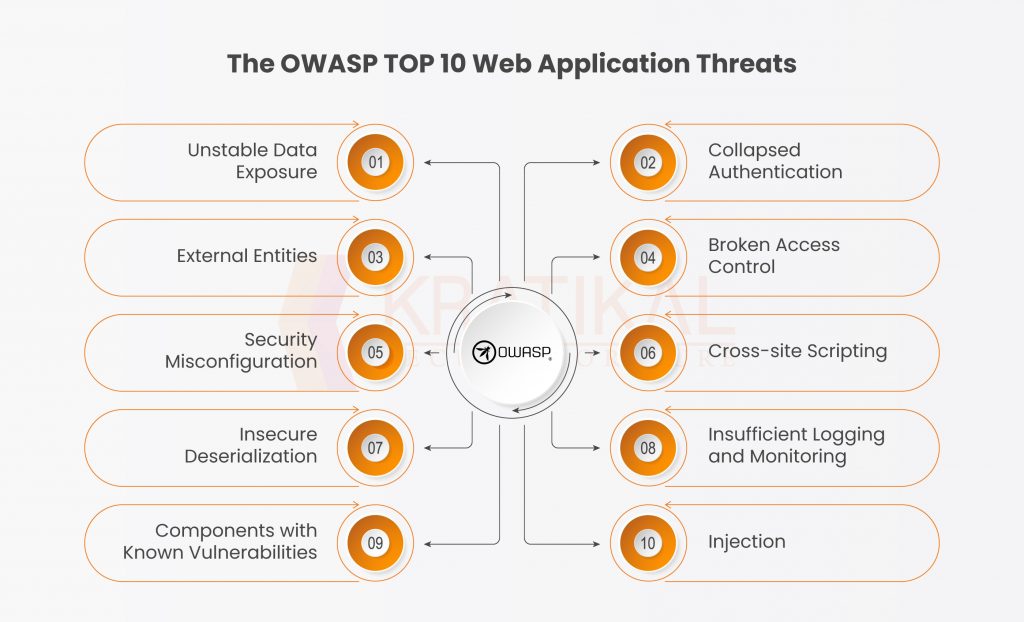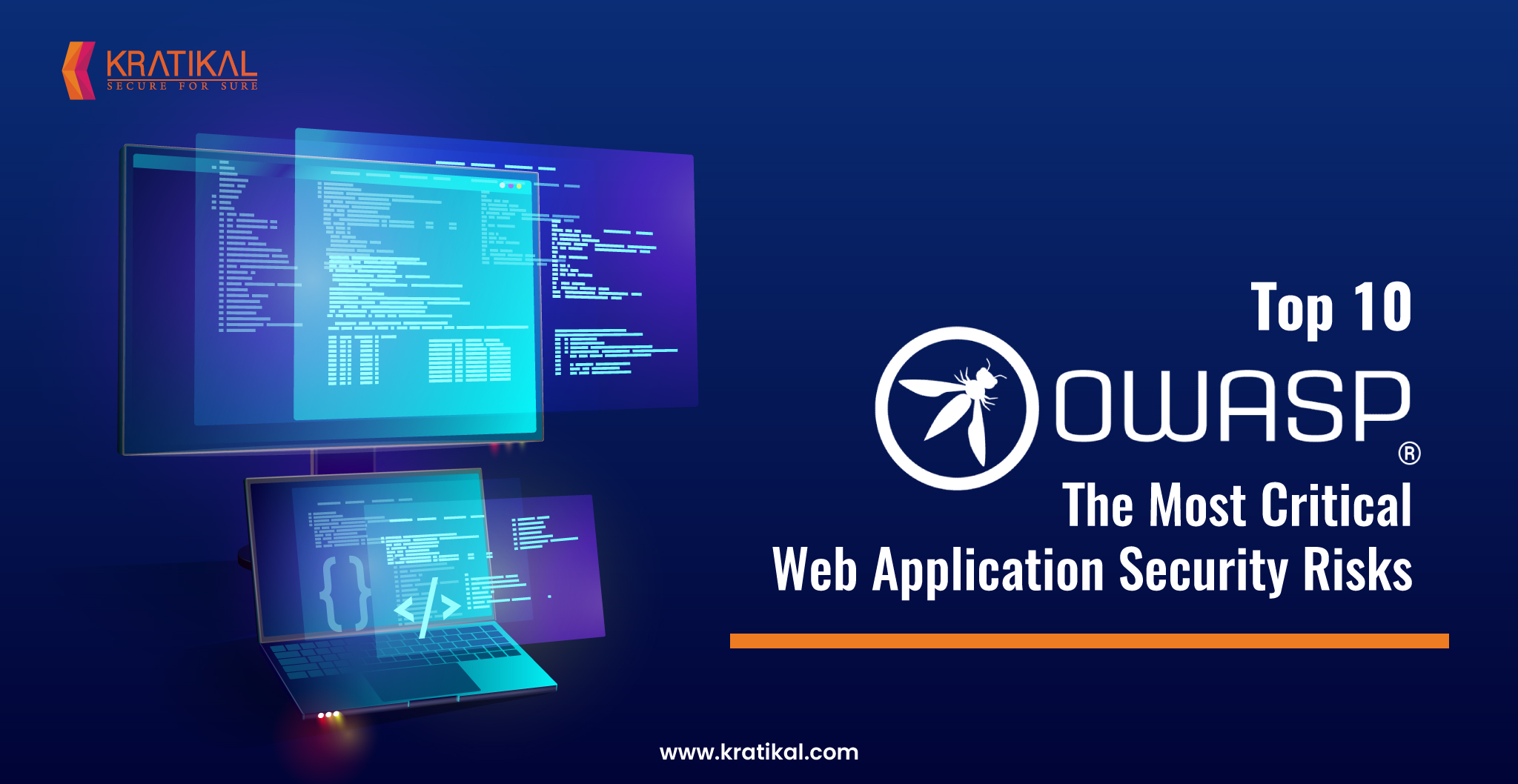Web applications are becoming more and more dependent as a result of the rise in cyberattacks, which makes them desirable targets. Sensitive data is accessed by key systems through online apps, increasing their susceptibility to security vulnerabilities.
A framework for comprehending and managing web application security concerns is provided by the Open Web Application Security Project (OWASP), a nonprofit organization.
The “OWASP TOP 10 List” is the main accomplishment of OWASP. The most typical flaws that attackers use to compromise web applications are covered in-depth in this list.
With the help of this blog, you can have a deeper look at the OWASP Top 10 list and learn more about each risk. Organizations may defend themselves against online threats and safeguard their sensitive data by being aware of and addressing these crucial web application security issues.
Table of Contents
Get in!
Join our weekly newsletter and stay updated
What is OWASP?
Open Web Application Security Project is what OWASP stands for. It is a global non-profit organization that concentrates on enhancing the security of software programs. Developers, security experts, and organizations can improve the security of their web applications by using the information, tools, and standards provided by OWASP.
The group is most well-known for its Top Ten Project, which lists the most critical web application security concerns and offers advice on how to address them. OWASP also organizes conferences, training sessions, and community activities to encourage education and cooperation in online application security. The purpose of OWASP is to strengthen online application security and safeguard users’ sensitive and personal data.
Benefits of OWASP
The OWASP Top 10 is a widely recognized and respected list of the most critical security risks to web applications. The OWASP 10 major area of focus is on the most critical threats rather than specific susceptibilities. They are considered the main standard awareness document for both the developers and web application security. There are a few benefits associated with OWASP 10 that will make you understand how important it is.
- Prioritization: The OWASP Top 10 lists security concerns in order of importance, enabling businesses to concentrate their efforts on the most pressing issues first.
- Compliance: A lot of regulatory and compliance frameworks demand that businesses take precautions to guard against the OWASP Top 10 dangers.
- Awareness – The OWASP Top 10 highlights the most prevalent security risks that online applications encounter. Developers and security experts are better able to handle these dangers by highlighting them.
- Education– For developers and security experts, the OWASP Top 10 is a great instructional tool. They can choose better ways to design, build, and secure their apps by being aware of the typical hazards that web applications encounter.
- Best Practices– A list of best practices for tackling typical security concerns in web applications is provided by the OWASP Top 10. Organizations may create more secure applications by implementing these recommended practices.
- Risk Management -The OWASP Top 10 can assist companies in determining and controlling their exposure to risk. Organizations can lessen the possibility and effects of successful attacks by addressing these basic risks.
The OWASP Top 10 is a crucial tool for anyone working on the design, testing, or security of web applications. Organizations can greatly enhance the security of their apps and lower their risk exposure by implementing the recommendations in this report.
Get in!
Join our weekly newsletter and stay updated
The OWASP TOP 10 Web Application Threats –
- Unstable Data Exposure
- Collapsed Authentication
- External Entities
- Broken Access Control
- Security Misconfiguration
- Cross-site Scripting
- Insecure Deserialization
- Insufficient Logging and Monitoring
- Using Components with Known Vulnerabilities
- Injection

Let us briefly explain the OWASP TOP 10 Web application security threats.
- Unstable Data Exposure – Financial, healthcare, and other personally identifiable information (PII) can be taken over or altered, used for fraud, identity theft, or other illegal actions if online apps and APIs are not adequately secured. Strong authentication, appropriate controls, encryption, and the deletion of superfluous data can all assist prevent exposure.
- Collapsed Authentication – Attackers have the ability to steal passwords and tokens, or pose as users when authentication is falsely enforced. Due to improperly established identification and access rules, this occurs endlessly. To assist prevent this issue, putting into place weak password checks and multi-factor authentication is an excellent place to start.
- External Entities – Internal port scanning, remote code execution, and DDoS attacks can be carried out by external actors, or they can be used to distribute internal files. While finding and removing XXE vulnerabilities can be challenging, there are several simple enhancements that can be made, such as – Updating all XML processors, ensuring thorough validation of XML input in accordance with a schema, and, when possible, limiting XML input.
- Broken Access Control– Broken access control usually results from insufficiently implemented user access regulations. As a result, hackers gain access to data and features they would not otherwise be allowed to use by taking advantage of weaknesses.
- Security Misconfiguration – The most frequent and usual dangers to organizations’ web security come from misconfigurations. They are brought on by inadequate or unsafe delinquency setups, public cloud storage, or cryptic error signals. To assist prevent security misconfiguration, all operating systems, frameworks, libraries, and applications must be securely configured, patched, and adhered to best practices recommended by each hardware or software manufacturer.
- Cross-Site Scripting (XSS) – When an application delivers untrusted data to a web browser without performing the necessary validation or escaping, an XSS vulnerability results. Via the use of cross-site scripting (XSS), attackers can run scripts in the victim’s browser that can hijack user sessions, alter websites, or divert users to dangerous websites.
- Insecure Deserialization – Insecure deserialization frequently results in remote code execution situations. These weaknesses allow replay, injection, and advantage escalation attacks to be carried out even if remote code execution doesn’t take place. Denying calibrated objects from unreliable sources is one approach to stop this from happening.
- Insufficient Logging and Monitoring – It may be difficult or even impossible to identify attackers or detect assaults with insufficient recording and monitoring. It’s frequently impossible to figure out what happened when breaches occur because of inadequate logging and monitoring.
- Using Components with Known Vulnerabilities– Libraries, frameworks, and other software modules, among others, virtually usually execute with full rights. A server takeover or significant data loss may result from an attack that successfully exploits a weak component.
- Injection – Untrusted data being given to an interpreter as part of a command or query can lead to injection issues in SQL, NoSQL, OS, and LDAP. The malicious data from the attacker can then control the activities of the interpreter.
Let’s deal with the Top 10 OWASP Threats
Businesses that do not adequately secure their online applications are more vulnerable to hostile assaults, which can lead to data theft, license revocations, strained client relationships, and legal action. Remember that there are thousands of vulnerabilities that can be exploited and manipulated by cybercriminals, and the OWASP Top 10 risks are the most insignificant.
While developing their security strategy, organizations may disregard online apps or believe their network firewalls would secure them. Consider integrating a web application firewall in your organization’s security strategy and technology stack to aid in your protection against the risks we mentioned above.
In addition to the aforementioned precautions, conducting routine vulnerability assessments and penetration tests is crucial. In order to assess a web application’s security flaws, VAPT searches for potential and frequent vulnerabilities related to the platform, technological framework APIs, etc. Reports on vulnerabilities found are given to the businesses, together with information on their type, threat level, impact, and remediation steps.
Want to Confirm the Security of Your Application?
Get your Application Security Testing Now!!









Leave a comment
Your email address will not be published. Required fields are marked *